Archive for August, 2012
August 29th, 2012 by dave dorsey
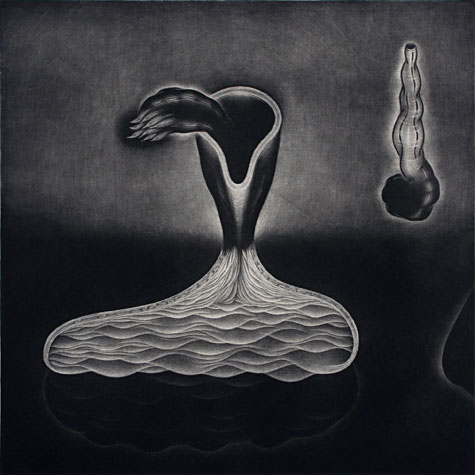
Steam of Lethe, Sean Caulfield
Manifest is offering a fascinating exhibit right now: two artist’s books that use printmaking to merge images and poetry inspired by Dante’s Inferno and Purgatorio. The work draws on visions from the Italian poet’s trilogy and then reworks them as a way of meditating on what Sean Caulfield sees as the contemporary crisis of our relationship to the natural world, including the human body itself. Caulfield, a Canadian artist, got the project rolling by devising images inspired by scenes in Dante’s great poem. Caulfield is a Centennial Professor in the Department of Art and Design at the University of Alberta, and has exhibited his prints, drawings and artist’s books extensively throughout Canada, the United States, Europe, and Japan. He took his images first to Jonathan Hart who wrote poetry based on Caulfield’s work, at which point the collaborators called on Sue Colbert who helped create a unified, integrated book out of the work they’d produced. Caulfield was originally inspired by William Blake’s illustrations for Dante and Milton, as well as that brilliant, eccentric poet/printmaker’s ability to weave his world out of both text and visual imagery.
What inspired me to send questions to Caulfield about his work was his reverence for poetic and artistic tradition—his eagerness to see contemporary relevance in work done centuries ago. More
August 28th, 2012 by dave dorsey
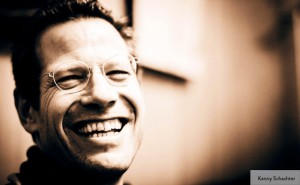
Kenny Schachter
Yesterday, an interesting and funny and startling conversation took place on Facebook between the informed and thoughtful curator Todd Levin and the self-described art hustler and polymath Kenny Schachter. It was a little like watching a car crash in real time, though no one really got hurt. More like a couple clown cars in a demolition derby. The conversation revolved around something Schachter wrote about Gallery Girls, a reality TV program built around the lives of young gallery workers. So this all started with a post from Schachter, who now does his thing in London. He’d gotten a scathing letter from the husband of a woman who had appeared in one episode of the show. His post:
Who is the poison pen in this instance, can someone please let me know, am i so terrible? Here is a scathing email I received, all because of this crap tv show I was asked to watch that was supposedly about the art market, not anyone’s academic achievements or accomplishments. Sorry.
Kenny,
I am a friend and subscriber of Marc Faber’s and so have read your art world More
August 27th, 2012 by dave dorsey
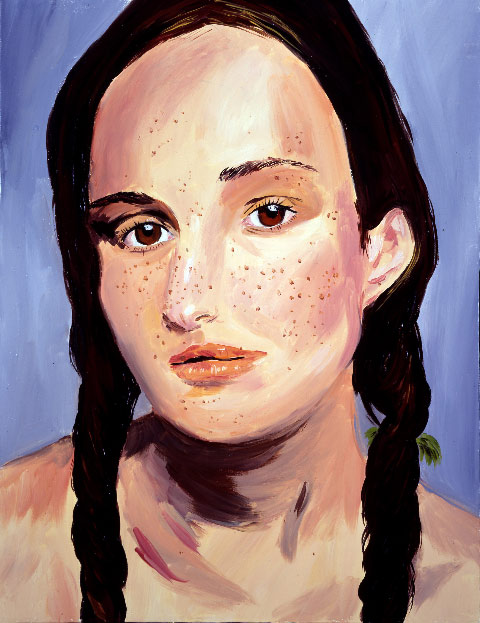
Karen Kilimnik, Me, Corner of Haight & Ashbury, 1966, 1998
Water soluble oil color on canvas
Should have started doing this from day one. A new, occasional department: Art I Love. Just great pictures, no words. (This was from a fascinating show Todd Levin curated.)
August 26th, 2012 by dave dorsey
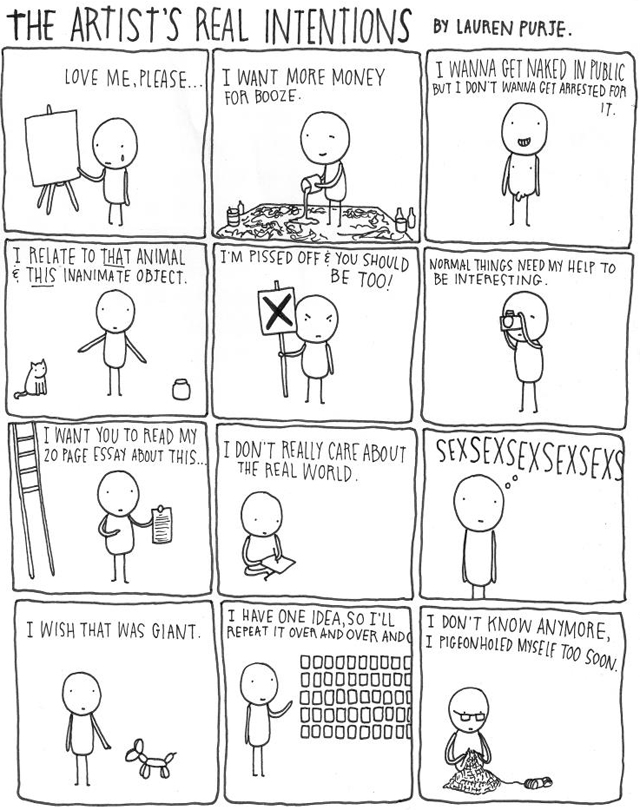
Lauren sent me an email a couple days ago: “Have you seen Hyperallergic today?” I knew what that meant. I don’t get many emails from her that don’t circle around to the subject of what she’s up to, so I figured somebody high on the 26th floor at Hyperallergic World Headquarters must have finally detected the sound of her painting boots stomping the floorboards at 3 a.m. all the way over on the other side of Brooklyn. Along with strains of Tom Waits from her Macbook. (That’s when she’s usually hard at work on her comics and paintings. I don’t think she actually sleeps.) So I clicked and found that one of my favorite art blogs had discovered her poster, which got tons of shares when she put it up on Facebook a while back. Right after she drew this, earlier this year, she showed it to me, while I was visiting Brooklyn, and pointed toward one of the panels and said, “That’s you.” At the time, I thought, “Oh, cool. I inspired one of these!” Upon further investigation (in other words, Lauren told me to get over myself, I wasn’t her inspiration) she merely meant that, as an artist, she was able to pigeonhole me into one of her well-observed categories. (This flattered me at first and then made me uncomfortable. Lauren’s too intelligent. She sees exactly where most things fall short of the ideal, and shortfall is my niche.) It’s unclear, at this point in time, which panel she meant when she was putting me in my place. I thought it was “Normal things need my help to be interesting.” However, she insists there’s a jar in here somewhere, and she knows I love to paint jars. Here’s the thing, though. Now I recognize myself in more than one of these drawings. At least three of them. Hm. No, five, actually. OK, this is as high as I’m going to go: eight. I’m definitely in eight of these. As Charlie Brown would have said if Lucy had drawn this: I am the inspiration for this comic, Linus! Then Lucy decks him with a roundhouse left.
One thing, though. Zero desire to get naked in public. Not that anyone was hoping.
August 16th, 2012 by dave dorsey
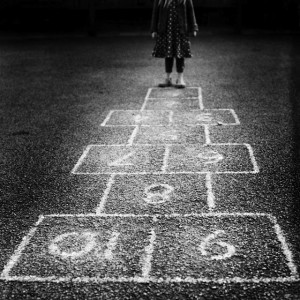
Playtime, by Deborah Parkin
When I read this, I thought, yes! That’s exactly right! And then I reread it and realized that this would be something almost anyone who practices any kind of unrecognized art would think. Which doesn’t make it any less valuable, of course, but it was the way she worked in her children and possible grandchildren that somehow caught my eye. And also the quality of what she’s doing in the context of her struggle with obscurity. “I have also found the Internet . . .” Funny. Uh, yeah, Deborah. Ampersands and all.
From Lenscratch:
As an emerging photographer, what insights can you share?
For me, it’s always been about the work. I never really imagined being published or having gallery representation etc – things like that were for other people. I just wanted to be a good photographer and leave something, a legacy for my children & maybe grandchildren. So ultimately I feel you need to work hard, learn your craft & be passionate about your subject. Do it for yourself because not everyone will like what you do & you can’t please everyone, so you must love doing what you do. I have also found the Internet to be an excellent way of sharing work & for being inspired by other artists too.
August 7th, 2012 by dave dorsey
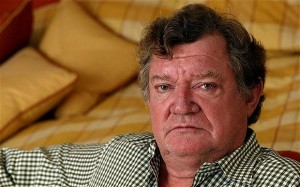
“Although art has always been a commodity, it loses its intrinsic value and its social use when it is treated only as a commodity. To lock it into a market circus is to lock people out of the contemplation of it. This inexorable process tends to collapse the nuances of meaning, and visual experience generally, under the brute weight of price. It is not a compliment to the work. If there were only one copy of each book in the world, fought over by multimillionaires and investment trusts and then hidden in storage, what would happen to one’s sense of literature—the tissue of its meanings that sustain a common discourse?”
Even better:
“The Cultural Cringe is the assumption that whatever you do in the field of writing, painting, sculpture, architecture, film, dance, or theater is of unknown value until it is judged by people outside your own society. It is the reflex of the kid with low self-esteem hoping that his work will please the implacable father, but secretly despairing that it can. The essence of cultural colonialism is that you demand of yourself that your work measure up to standards that cannot be shared or debated where you live. By the manipulation of such standards, almost anything can be seen to fail, no matter what sense of finesse, awareness, and delight it may produce in its own setting.”
–Robert Hughes
1938-2012





